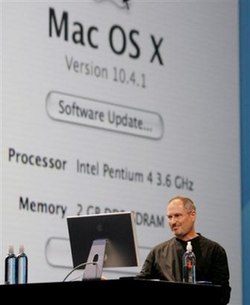1999
WWDC 1999 was opened by HAL9000. Jobs delivered an update, saying that 3,106 Mac apps were announced since May 6, 1998 (the debut date of iMac); Dragon Systems was bringing its voice-recognition software to the Mac, and he introduced Janet Baker (co-founder and CEO of Dragon Systems). Jobs updated Apple's profits, units, inventory and cash, announcing that Sears would be added to its national distribution chain. Apple Inc. launched its store on Memorial Day 1999, and Jobs announced the PowerBook line. During the one-week conference, Apple gave away 50 PowerBooks to attending developers. Jobs delivered an update on OpenGL, Java and QuickTime, inviting Avie Tevanian and Phil Schiller onstage. Schiller demonstrated OpenGL, QuickTime 4, Sherlock 2, the Quartz graphics model, Finder and the MailViewer app. Jobs announced Java MRJ 2.1.2, the fastest Mac Java to date, and he and Tevanian demonstrated Java. He reviewed Mac OS 8.5 (released in October 1998), announced Mac OS 8.6, previewed Sonata (scheduled for release in fall 1999) and delivered an update on Mac OS X Server 1.0. Jobs said that in the Darwin open-source software program there were over 20,000 registered developers and over 175,000 component downloads, describing the three application environments on the Darwin-Quartz foundation. The first was Classic Environment (formerly named Blue Box); the second was Carbon (API) (announced at WWDC 1998), and the third was Cocoa (API) (formerly named Yellow Box). Apple was developing a new Finder and a new Mail.
At the August 31, 1999, Seybold Seminars Expo, Jobs delivered an update on Apple, announcing its June quarterly profits, the appointment of Mickey Drexler (of Gap Inc.) to the board of directors, and giving an overview of QuickTime. Apple partnered with Akamai Technologies as a broadcast network, with content provided by BBC News, Bloomberg Television, Fox News, Fox Sports, HBO, NPR, The Weather Channel, WGBH-TV, ABC News, ESPN, Rolling Stone, VH1, and Disney; new content was provided by Rhino Records and Warner Bros. Records. Phil Schiller demonstrated QuickTime TV, Sherlock 2, VoicePrint, AppleScript and the Power Mac G4, and Jobs previewed Mac OS 9. He demonstrated nine features: Sherlock 2, a shopping app; Multiple Users, with privacy and preferences for a number of users; VoicePrint Password, voice-recognition software; Keychain, with one password; Auto Updating, for the latest updates; Encryption, for private files; File Sharing Over Internet; AppleScript over TCP/IP, to manage workflow across computers, and Network Browser. Jobs reviewed the iMac, introducing Ozzie Osborne (general manager of speech systems at IBM) to demonstrate ViaVoice. Jobs reviewed iBook (showing two TV advertisements) AirPort (showing the AirPort Base Station TV ad), the PowerBook and the Power Mac G4, calling computer scientist Richard Crandall onstage to demonstrate the G4. Jobs introduced John Warnock, chairman and chief commercial officer (CCO) of Adobe Systems. Jobs showed a Power Mac G4 TV ad, and introduced the Apple Cinema Display.
On October 5, 1999, Jobs said that Akio Morita of Sony had died two days earlier, announced the Mac OS 9 and described the nine internet power tools. Phil Schiller demonstrated Sherlock 2, Multiple Users, VoicePrint Password, Keychain, Encryption, Network Browser and Auto Updating. Jobs reviewed the Power Mac G4, showed a TV ad, and reviewed the Apple Cinema Display, PowerBook, and iBook. He announced the new iMac, and Schiller demonstrated the graphics card. Jobs introduced and demonstrated the iMac DV and iMovie, and showed three TV commercials.


